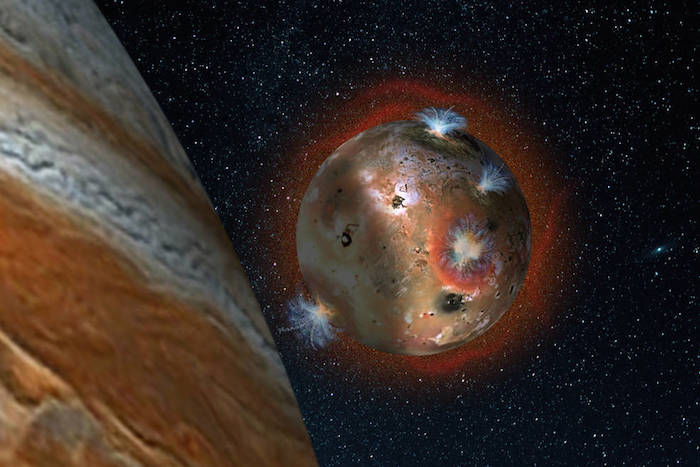2.08.2016
Jupiter’s volcanic moon Io has a thin atmosphere that collapses in the shadow of Jupiter, condensing as ice, according to a new study by NASA-funded researchers. The study reveals the freezing effects of Jupiter’s shadow during daily eclipses on the moon’s volcanic gases.
“This research is the first time scientists have observed this remarkable phenomenon directly, improving our understanding of this geologically active moon,” said Constantine Tsang, a scientist at the Southwest Research Institute in Boulder, Colorado. The study was published Aug. 2 in the Journal of Geophysical Research.
Io is the most volcanically active object in the solar system. The volcanoes are caused by tidal heating, the result of gravitational forces from Jupiter and other moons. These forces result in geological activity, most notably volcanoes that emit umbrella-like plumes of sulfur dioxide gas that can extend up to 300 miles (480 kilometers) above Io and produce extensive basaltic lava fields that can flow for hundreds of miles.
The new study documents atmospheric changes on Io as the giant planet casts its shadow over the moon’s surface during daily eclipses. Io’s thin atmosphere, which consists primarily of sulfur dioxide (SO2) gas emitted from volcanoes, collapses as the SO2freezes onto the surface as ice when Io is shaded by Jupiter, then is restored when the ice warms and sublimes (i.e. transforms from solid back to gas) when the moon moves out of eclipse back into sunlight.
The study used the large eight-meter Gemini North telescope in Hawaii and an instrument called the Texas Echelon Cross Echelle Spectrograph (TEXES). Data showed that Io’s atmosphere begins to “deflate” when the temperatures drop from -235 degrees Fahrenheit in sunlight to -270 degrees Fahrenheit during eclipse. Eclipse occurs two hours of every Io day (1.7 Earth days). In full eclipse, the atmosphere effectively collapses, as most of the sulfur dioxide gas settles as frost on the moon’s surface. The atmosphere redevelops as the surface warms once the moon returns to full sunlight.
.

“This confirms that Io’s atmosphere is in a constant state of collapse and repair, and shows that a large fraction of the atmosphere is supported by sublimation of SO2 ice,” said John Spencer, a co-author of the new study, also at the Southwest Research Institute. “Though Io’s hyperactive volcanoes are the ultimate source of the SO2, sunlight controls the atmospheric pressure on a daily basis by controlling the temperature of the ice on the surface. We’ve long suspected this, but can finally watch it happen.”
Prior to the study, no direct observations of Io’s atmosphere in eclipse had been possible because Io’s atmosphere is difficult to observe in the darkness of Jupiter’s shadow. This breakthrough was possible because TEXES measures the atmosphere using heat radiation, not sunlight, and the giant Gemini telescope can sense the faint heat signature of Io’s collapsing atmosphere.
The observations occurred over two nights in November 2013, when Io was more than 420 million miles (675 million kilometers) from Earth. On both occasions, Io was observed moving into Jupiter’s shadow for a period about 40 minutes before and after the start of the eclipse.
The research was funded by NASA’s Solar System Workings and Solar System Observations programs.
Quelle: NASA
-
Update: 3.08.2016
-
Volcanic moon's atmosphere freezes daily in Jupiter's shadow
Sulfur dioxide in Io's atmosphere falls to the surface as frost when the gas giant's completely blocking the sun.

Jupiter's massive tidal push and pull bestows explosive volcanism on its innermost moon Io. But the gas giant's huge shadow also freezes Io's atmosphere on a daily basis, crystallising sulfur dioxide gas into ice which falls onto the moon's surface as frost.
Constantine Tsang from the Southwest Research Institute in Boulder, Colorado and colleagues in the US, France and Spain recorded, for the first time, how Io's atmosphere behaves during its orbit around Jupiter from sunshine to shadow.
In a study published in the Journal of Geophysical Research Planets, they saw the atmosphere begins to “deflate” when the temperatures drop from around -150 °C in sunlight to around -170 °C during eclipse which happens two hours of every Io day (1.7 Earth days).
The atmosphere puffs up again as the surface warms once the moon returns to full sunlight.

“This research is the first time scientists have observed this phenomenon directly, improving our understanding of this geologically active moon,” Tsang says.
Prior to their work, astronomers found it tricky to directly observe Io’s atmosphere in the darkness of an eclipse.
But Tsang and colleagues were able to do so as the Texas Echelon Cross Echelle Spectrograph on the Gemini telescope in Hawaii measured the atmosphere using heat radiation – not sunlight.
This way, they picked up the faint heat signature of Io’s collapsing atmosphere.
Quelle: COSMOS
